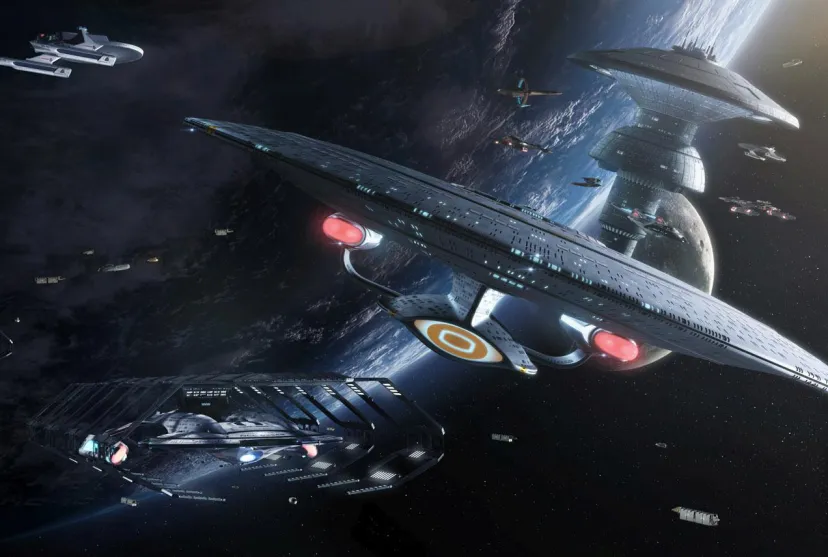Seeking “Strange New Worlds” is the key vision of Star Trek Adventures Second Edition, the latest version of the Star Trek TTRPG. Published during GenCon, the game has made strides to adapt the system to simplify mechanics and combat in order to give players more control over the story and to incentivize engagement. The game makes big promises, but offers a flexible and easy-to-learn system of rules to operate around.
How Does Star Trek Adventures Work?
Star Trek Adventures operates on the 2d20 system, the system created by Modiphius and used across a number of their properties. A player will combine two stats together to create the metric they’re rolling on. For example, let’s say a Starfleet captain wants to get a squad of cadets into shape. He would combine his attribute of Control (in this case, 9) with his discipline of Command (we’ll say 4) to make the set number 13. So you, as the player, are aiming to roll and get numbers below the number. Players will then roll two d20 and try to get below that number. If he wanted to do that with a ship, he’d use the ship’s stats alongside his own disciplines.
There are a number of ways that players can get additional dice on top of the d20, but that’s dependent on Momentum (a shared currency among players), talents (special skills the player might have) and focuses (areas of expertise.)
There’s also the risk of Threat. Threat is a currency available to the storyteller that they get to spend to affect the story process. If the storyteller wants to create a complication (such as a phaser malfunction) then they’d have to spend Threat to do so. This currency is limited, but player actions and player behavior can give a GM more of the currency as the story; particularly if they don’t want to take damage or risk their character in notably volatile scenarios.
What the Second Edition added was the power of traits or keywords. The game now has a GURPS-like functionality where players and storytellers now have the ability to add special traits which can add complication. For example, if the players find an abandoned spaceship, it might have the Trait “lacking key systems.” Players can take actions, make checks or strike to do something about this trait to perhaps change it.
Players, items and locations will all bear traits, which may simplify or complicate a player’s interaction with another party. For example, a human Starfleet officer would likely have a harder time convincing a Cardassian to not fight them than, say, another Cardassian. That’s just the inherent nature of the traits. Some of these are set, while others are flexible to player creativity. They just might come at the cost of player resources, or Momentum.

Changes to Second Edition
Star Trek Adventures has made more than a few significant changes to its systems. One of the most visible changes within the system is the removal of challenge dice, a device that used multiple dice to affect whether or not a certain task could be completed. Now there are only D20s, which affect how ship combat, extended tasks and personal combat operate.
It has also refined starship mechanics. A Star Trek ship is as much a character as the player at times, and the new rules have added improved guidance for using it out of combat, simplifying the combat process, minimizing the tracking of resources the ship might have and other things.
A number of non-playable races are now available from the start, including Romulans, Klingons and Cardassians.
My Response to the New Changes:
I’m newer to Star Trek Adventures, so going into the rule system took some time and processing. But I’ve been a Star Trek fan since I was a child. I find myself increasingly thankful for the new approach to the game’s mechanics, in that the focus on momentum, threat and player stress allow some flexibility but also emphasizes tension and potential.
The concepts of Momentum and Threat felt initially foreign to me as a 5e dungeon master. I’m used to having the ability to say “this is true because I say so.” But having an external currency to track where the story had quite a few benefits in the one-shot I was able to try. It offered a visible metric to let the players know how much trouble they were in, as well as a currency to interact with to either avoid personal harm or push the story. Momentum, in contrast, allowed them a language for responding and having those TV-esque moments of brilliance or success. Will they take the risk and push through the problem at the last moment, or will they flop and flounder? It’s a riveting notion that potentially mimics the episodic storytelling of Star Trek from the past.
The two currencies do take some time to get used to, and players required quite a bit of handholding to grasp at how this might work. But given time, I’ve no doubt that most player groups will figure out the back-and-forth underlying Momentum and Threat.
The game also puts a heavy weight on collaboration and cooperation. While many fans (and Starfleet officers) want to sit in the captain chair, STA’s mechanics are built around teamwork and creative cooperation. A ship needs a crew in order to operate effectively, and the same can be said of STA. Being the chief of security or science officer doesn’t mean players can’t have a starring role in a story, however. Star Trek offers a multitude of scenarios for them to step up and succeed, whether it is while fending off invaders, solving a complicated space anomaly or saving the lives of critical crew members under duress. The players will just have to learn how to share first.
Conclusion:
Star Trek Adventures is an exciting tool and opportunity for science fiction fans and TTRPG fans alike. The game offers an episodic and speedy approach to gameplay that is flexible and adjustable. While the 2d20 system and Momentum will require time to adapt to, players are sure to catch on quickly and find it a delightful chance to dive into the Galactic Federation and make a name for themselves.
The game is backwards compatible and can be used in tandem with Modiphius’ previously published volumes of Star Trek content.
Images via Modiphius and Paramount


